Tomato VIGS Protocol
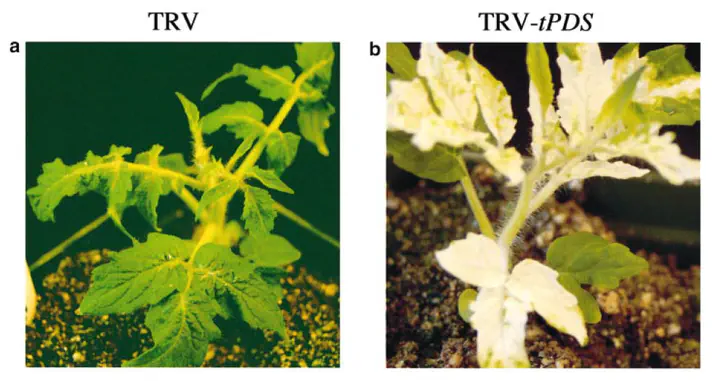 VIGS plants from Yule Liu et al.
VIGS plants from Yule Liu et al.VIGS tools
番茄VIGS片段选择网站,VIGS tools。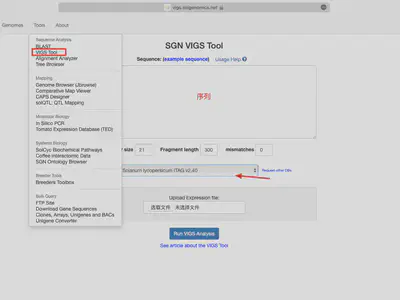
填入目的基因CDS序列,然后默认参数,选择物种数据库,点击Run。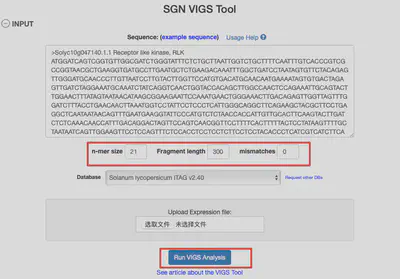
输出结果黄色区域为特异性片段,用于VIGS。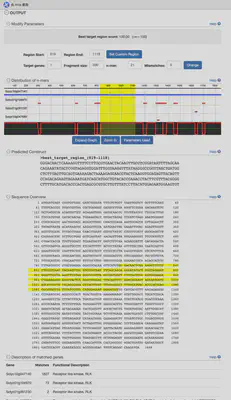
设计引物扩增片段,并构建至pTRV2载体。
Part I Cotyledon infiltration
Plant material
Tomato (Solanum lycopersicum) 生长约7-9天,两片子叶完全展开,真叶还未出现。
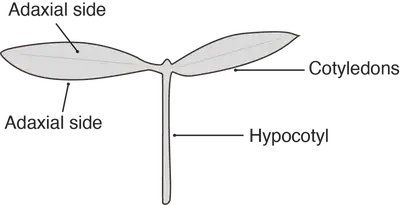
VIGS
DAY1
GV3101 harboring pTRV1, pTRV2, pTRV2-PDS, pTRV2-target gene are grown on LB agar plates containing 50 µg/mL of Kan and 25 µg/mL of rifampicin. Incubate at 28°C for 2 days.
DAY3
Inoculate a 2-3 mL liquid culture of LB with the above mentioned antibiotics for each of the strains. Shake at 28°C for 16-18 h.
DAY4
Inoculate a 1:25 (2 ml strains: 50 ml IM)dilution of the primary culture into a secondary liquid Induction Media (IM) IM culture with kan, rif and 200 µM acetosyringone.
DAY5
Harvest the cells, at 3000 g for 10 min. Resuspend in the same volume that the original culture had with resuspend buffer (10 mM MgCl2, 10 mM MES pH 5.5).
Centrifugue for 10 min at 3000 g. Resuspend cells in 10 ml resuspend buffer, then adjust OD600=1.0.
Add acetosyringone to a final concentration of 400 µM to the pTRV1 culture.
The different pTRV2 constructs are mixed into 50 mL conical tubes with an equal volume of pTRV1 suspension, resulting in a final acetosyringone concentration of 200 μM.
Individual seedlings were inoculated through the abaxial side of the cotyledon. Plants were incubated at 21-22 °C and covered to avoid light for 24 hours and returned to 16/8 h day-night cycles at the same temperature (21-22°C). Approximately 3 weeks later, the 4th true leaf of VIGS-PDS plant was observed for bleaching phenotype or sampled for qPCR assay.
Reagents
Prepara of Induction Medium (IM)
| V or W | Reagents |
|---|---|
| 400 mL | ddH2O |
| 4.88 g | MES (2-(4 morpholino)-ethane sulfonic acid) |
| 2.5 g | Glucose |
| 0.12 g | NaH2PO4 |
Note: Bring to a final volume of 475 mL with dH2O and adjust the pH to 5.6. Autoclave. After the medium has cooled down, add 25 mL of 20X AB salts.
Preparation of AB salts
| W | Reagents |
|---|---|
| 20 g | NH4Cl |
| 6 g | MgSO4·7H2O |
| 3 g | KCl |
| 0.2 g | CaCl2 |
| 0.05 g | FeSO4·7H2O |
Bring to a final volume of 1 liter with distilled water. Autoclave. Be aware that AB salts precipitate as an orange powder. Just mix them well by swirling before their use.
Preparation of 200 mM Acetosyringone. Please note that acetosyringone should be prepared the day it will be used
| W | Reagents |
|---|---|
| 19.6 mg | Acetosyringone (3’, 5’-Dimethoxy-4’-hydroxyacetophenone) |
| 500 µL | DMSO (Dimethyl sulfoxide) |
References
André C. Velásquez, Suma Chakravarthy, Gregory B. Martin. Virus-induced Gene Silencing (VIGS) in Nicotiana benthamiana and Tomato. Journal of Visualized Experiments. 2009. 1292 doi:10.3791/1292
Part II Sprout vacuum-infiltration
Plant material
Tomato sprouts come from seeds. Sprouts are easy to obtain about 2days.
VIGS
DAY1
GV3101 harboring pTRV1, pTRV2, pTRV2-PDS, pTRV2-target gene are grown on LB agar plates containing 50 µg/mL of Kan and 25 µg/mL of rifampicin. Incubate at 28°C for 2 days.
DAY3
A single colony was picked and inoculated in 2 mL LB with appropriate antibiotics(50 µg/mL of Kan and 25 µg/mL of Rifampicin). Shaking at 200 rpm at 28°C for 10 h (Overnight)
DAY4
500 µl of above culture was inoculated into a 2-3 mL LB containing antibiotics, 10 mM MES and 20 µM acetosyringone. Shaking at 200 rpm at 28°C for 10 h. Each Agrobacterium strain containing TRV1 and TRV2 vectors were mixed in 1:1 ratio.
Harvest and resuspend into infiltration buffer with 10 mM MgCl2, 10 mM MES and 200 µM Acetosyringone, pH 5.6, adjust to an OD of 1.0 and left at RT for 3-4 h.
Silwet L77 was added to cell solution (0.05%, v/v, 1 µL:2 mL) and mixed well immediately.

30 seeds each group were placed in 6 ml mixture strains, and then Vacuum-infiltration. Vacuum 5 times for 30 seconds each time.
Sow shallowly, sprinkle a shallow layer of soil over the surface of the seed. In about 4-5 days, the seeds can break out of the soil and the shoot begin to grow.
True leaf emergence (Approximately 7-9 days)
播种之后,大概7-9天,子叶开始出现。种子萌发时间不同,有些种子发芽慢,因此长短不齐。由此可见,最好使用萌发程度一致,容易控制取样时间并且保证实验一致性。
12 Days after infiltration
抽真空后12天,真叶继续生长,很多苗开始变白,PDS沉默效果显现。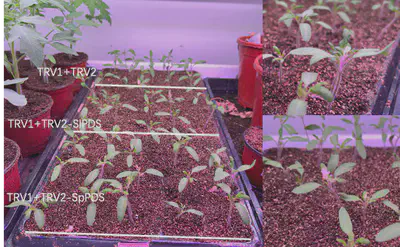
20 Days after infiltration
抽真空后20天,继续生长,栽培番茄基本还是呈现斑点状分布,PDS沉默效果显现。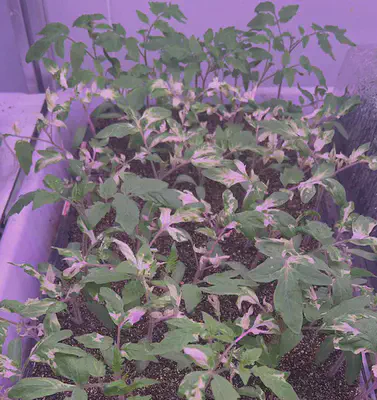
28 Days after infiltration
大约一个月左右,番茄进一步生长,VIGS效果进一步提升。SlPDS和SpPDS效果出现了差别,有SlPDS沉默效果更明显了,叶片特别白,SpPDS还是呈现点状为主。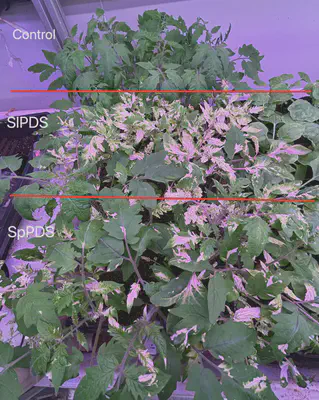
Fruit VIGS
Plant infiltration were performed as described in Ratcliff et al. (2001), with the modification used in tomato fruit. The Agrobacterium strain GV3101 containing pTRV1 or pTRV2 and its derivatives were used for VIGS experiments. The Agrobacterium strain GV3101 containing TRV-VIGS vectors was grown at 28°C in LB medium containing 10 mM MES and 20 mM acetosyringone with appropriate antibiotics. After 24 h, Agrobacterium cells were harvested and resuspended in the Agrobacterium infiltration buffer (10 mM MgCl2, 10 mM MES, pH 5.6, 150 mM acetosyringone) to a final OD 600 of 1.0 (for both pTRV1 or pTRV2 and its derivatives) and shaken for 4–6 h at room temperature before infiltration.
For tomato fruit infiltration, each Agrobacterium strain containing pTRV1 and pTRV2 or its derivative vectors were mixed in a 1:1 ratio and infiltrated into the carpopodium of tomato fruit attached to the plant in about 10 days after pollination with a 1-ml syringe .
Reference
Yan et al. Plant Cell Reports. 2012. 31: 1713–1722
Fu, Zhu, Zhu, Jiang & Luo. The Plant Journal. 2005. 43: 299–308